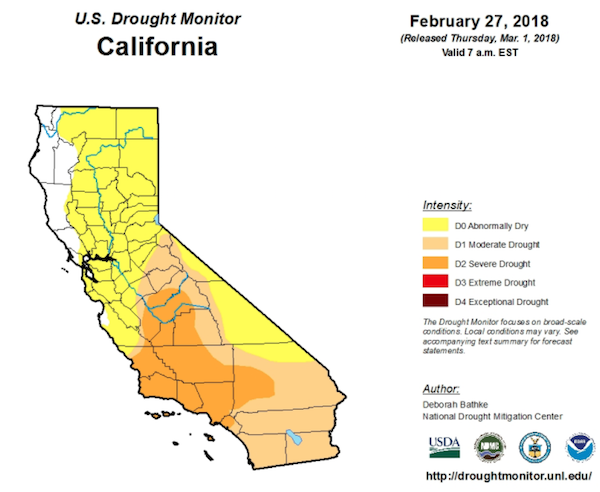The winter rainy season is drawing to a close here in California, and it’s been disappointing. Nearly all of the state’s water comes from rain that falls from October through March, so water worriers (nearly all residents after the brutal five-year drought) are concerned. We were rescued by a near-record rainy season in 2016-17 but this year has been dry, and drought conditions have returned:

The state got a nice storm last week which brought hopes that much of the water deficit was ended, but that optimism was unrealistic.
Meanwhile, I continue to keep an eye [1] on the countdown to No Water in Cape Town, South Africa, population four million. The situation there is dire, where Day Zero when taps run dry is now forecast to be July 9 [2]. One irritant is the practice of the press to emphasize climate change [3] and to ignore excess population for a region with only 20 inches of annual rain during normal times [4].
California is also overpopulated when its historically sketchy water supply is considered: the state is now approaching 40 million, of whom 10.7 million are foreign born [5] according to 2015 estimates. Governor Jerry Brown fancies himself to be an environmentalist, but he forgets the overpopulation part when it comes to immigration. In fact, in 2014 during the depths of the last drought, he welcomed all of Mexico to move to California [6].

Back to the recent snowpack report:
Even after storm, California’s Sierra snowpack at 37 percent of average [7], San Francisco Chronicle, March 5, 2018
The storm that wrought avalanches at ski resorts and whiteouts on mountain roads last week was so fierce that California water officials postponed their much-anticipated monthly survey of snow depth, setting the stage for potentially better news this week.
But on Monday, when officials finally lugged their gauges into the High Sierra for their periodic made-for-TV measurement, they confirmed their suspicions: The biggest storm of the winter had done little to alter the state’s swing toward renewed drought.
California’s all-important snowpack measured 39 percent of average for the date at Phillips Station in El Dorado County, the state’s traditional survey spot south of Lake Tahoe, while snowpack statewide measured 37 percent of average.
“No, we’re not looking OK,” said Frank Gehrke, chief of the California Cooperative Snow Surveys Program for the Department of Water Resources. “It’s a much rosier picture than a week ago, but it does illustrate the need for everyone to be prudent in their use of water.”
California’s winter has been disappointingly dry. Some parts of the state have seen less than a fifth of average precipitation since October, the usual start of the wet season. The Bay Area has received a little more than half its average.
While last winter delivered record-breaking storms that ended a historic, five-year drought, nearly 50 percent of the state has slipped back into at least moderate drought conditions, according to the U.S. Drought Monitor.
California’s snowpack is vital for these drier areas. Reservoirs capture the runoff, and the state’s sprawling network of aqueducts carries it to the cities and farms that lack enough water of their own. As much as a third of the state’s water supply comes from the snow in the Sierra Nevada and lower Cascades.
Last week’s storms provided a welcome boost to the snowpack. As much as 8 feet of snow fell in the mountains in some spots, with avalanches reported at Mammoth Mountain and Squaw Valley, where guests were injured and a snowboarder temporarily buried. The Internet brimmed with photos of cars rolling into giant snowbanks.
At Phillips Station, just north of the Sierra-at-Tahoe resort, state surveyors found Monday that the snow level more than tripled over the course of a week, from 13 inches to 41.1 inches. The water content of the snow, which is what really matters to drought-worried officials, rose from 7 to 39 percent of average for the date.
(Continues)